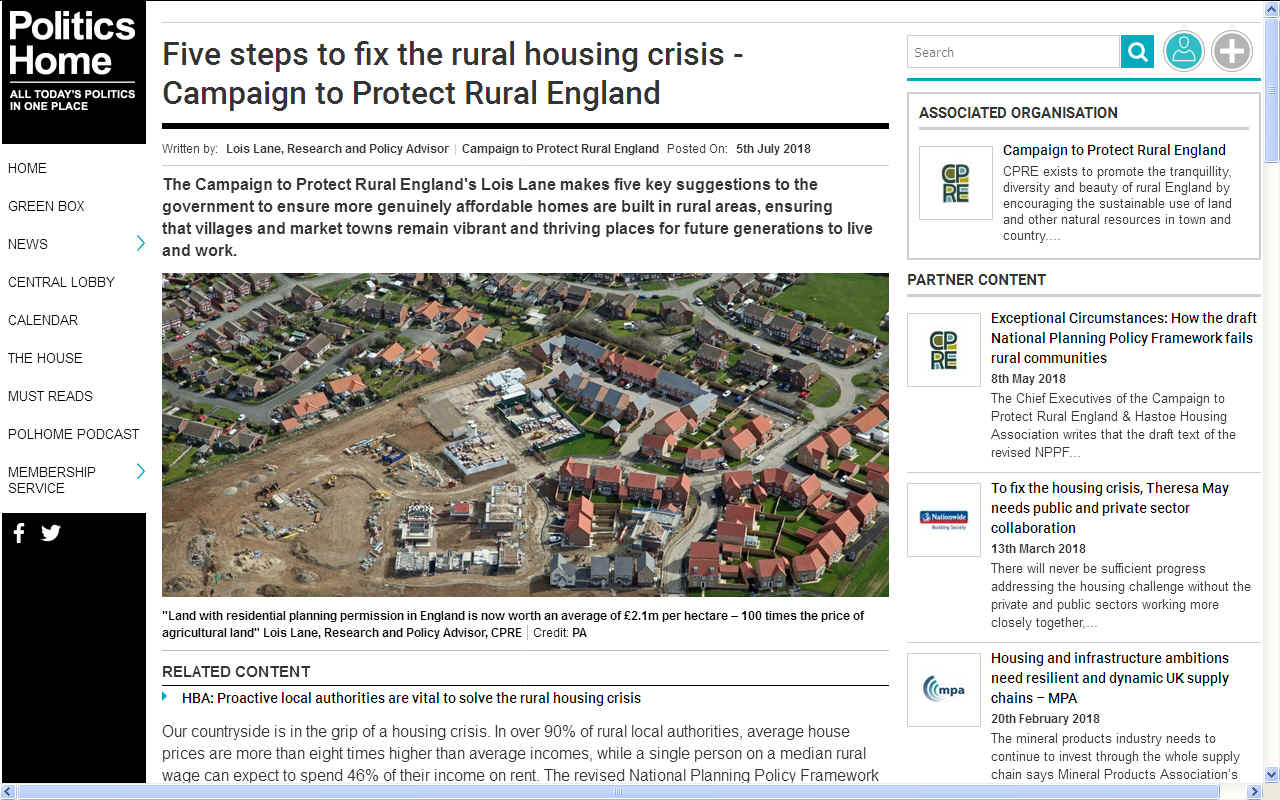|

CPRE
- The secret to effective campaigning is to get to know your
councillors, then the officers of the council who control the members.
Once you have identified the actual chain of command, challenge the controlling
minds. Make then account for their actions. Local parish
councils usually have members who are related to builders and
architects. They sit in on and influence the other members who are
allowed to vote, even when not saying anything. As an example of
potentially inappropriate liaisons, Susan
Stedman, the chairwoman of Area Plans South Planning Committee at Wealden
District Council, is partner to an architect. If it was that he was
getting work from consents that this lady was passing when they come up
for consideration by her Committee, that would be unlawful. We are of
course not suggesting that is the case. We are simply giving this as an
example of what to look out for.
The
moment land is earmarked for development it shoots up in value. That is
why land for affordable houses should be set aside before considering
market value houses. Councils are failing to identify and reserve land
for affordable house building. That is another reason it is near
impossible, at the moment, to persuade developers to build sustainable
housing, because they know they can bargain with the councils they are
already in bed with.
POLITICS HOME 5 JULY 2016 - 5 STEPS TO FIX RURAL HOUSING CRISIS
The Campaign to Protect Rural England's Lois Lane makes five key suggestions to the government to ensure more genuinely affordable homes are built in rural areas, ensuring that villages and market towns remain vibrant and thriving places for future generations to live and work.
Our countryside is in the grip of a housing crisis. In over 90% of rural local authorities, average house prices are more than eight times higher than average incomes, while a single person on a median rural wage can expect to spend 46% of their income on rent. The revised
National Planning Policy Framework
(NPPF) and forthcoming Social Housing Green Paper both offer opportunities for the Government to demonstrate that it is serious about tackling this rural housing crisis; but to do so they must:
>>
Help to bring forward land cheaply
>> Hold developers accountable
>> Be properly rural-proofed
>> Empower rural communities
>> Build more genuinely affordable homes
Bringing forward land at a fair price
Tackling land price inflation is crucial if we are to build more genuinely affordable homes in rural areas. Land with residential planning permission in England is now worth an average of £2.1m per hectare – 100 times the price of agricultural land. To avoid exacerbating the problem still further, the Government must scrap the ill-conceived and ambiguously worded policy on Entry Level Exception Sites in the draft NPPF, which will succeed only in inflating land values in rural areas and undermining the delivery of genuinely affordable homes on Rural Exception Sites. Longer term, the government may also wish to consider more comprehensive forms of land value capture, as suggested in their ‘Supporting housing delivery through developer contributions’ consultation paper.
Holding developers accountable
In our recent ‘Viable Villages’ report with Shelter, we demonstrated the damaging impact that viability assessments can have on rural communities. In 2015/16, across the eight rural local authorities surveyed, the use of viability assessments led to a 48% drop in affordable homes delivered. We are calling on the Government to amend its Planning Practice Guidance on Viability, to state that viability should be assessed at the plan-making stage across a whole local plan area, and that the resulting developer obligations should be seen as a clear and agreed minimum standard, not the starting point for negotiation.
Rural-proofing policy
We have seen before that well-intentioned government policies can have unintended consequences for rural communities if they are not properly rural-proofed. For example, the 2014 decision to exempt sites of fewer than 10 dwellings from planning obligations was designed to support SME builders and streamline development. Yet 84% of rural developments in the preceding year were on sites of fewer than 10 homes. Exempting small sites from developer contributions has had a profound impact on rural affordable housing delivery ever since. We urge the Government to remove the 10 unit threshold, and to ensure that future housing policies are designed with the specific needs of rural communities in mind.
Empowering rural communities
If we are to build not only the quantity but also the type and quality of homes the country needs, then communities must be able to promote and shape the kind of development they wish to see in their local area. Neighbourhood planning can be an important mechanism for communities to achieve this, but the opportunity to feed into an accessible and transparent local plan consultation process is also vital. We would like to see the final NPPF strengthened to ensure that development which does not conform to local and neighbourhood plan policies can be rejected, unless the proposal in question is genuinely community led.
Building more genuinely affordable homes
Of course, solving the housing crisis in the countryside is not just about making sure that local authorities and communities have the right policy levers at their disposal. If we are ever to build enough genuinely affordable homes in rural areas, we need the right funding to pay for them. MHCLG figures reveal that last year only 990 homes for social rent were built in rural local authorities. At that rate, it would take 180 years to build enough homes to house the 177,600 rural families on council waiting lists in 2017. We urge the Government to use its Social Housing Green Paper to initiate a new social
house building programme on a significant scale, and to ring-fence a proportion of grant funding for use in rural areas, in line with the proportion of the
population who live in them.
Only with concerted, decisive Government action will we see more genuinely affordable homes built in rural areas, and ensure that our villages and market towns remain vibrant and thriving places for future generations to live and work.
By Lois Lane, Research and Policy Advisor
ABOUT
CPRE
The Campaign to Protect Rural England (CPRE) is a registered charity in England with over 40,000 members and supporters. Formed in 1926 by Sir Patrick Abercrombie to limit urban sprawl and ribbon development, the CPRE (until the 1960s the Council for the Preservation of Rural England and from then until 2003 the Council for the Protection of Rural England) claims to be one of the longest running environmental groups. CPRE campaigns for a "sustainable future" for the English countryside. They state it is "a vital but undervalued environmental, economic and social asset to the nation." They aim to "highlight threats and promote positive solutions." They campaign using their own research to lobby the public and all levels of government.
CPRE has influenced public policy relating to town and country planning in England, most notably in the formation of the National Parks and AONBs in 1949, and of green belts in 1955.
It claims some credit for the slow shift of agricultural policies across
Europe away from a price-support philosophy to one of environmental stewardship, a policy shift begun in England. Campaigns against noise and light pollution have been pursued over recent years, and CPRE is now focusing on "tranquillity" as a key aspect of the countryside which CPRE wants to see protected in England’s planning policies.
CPRE joined the 10:10 project in 2010 in a bid to reduce their carbon footprint. One year later they announced that they had reduced their carbon emissions (according to 10:10's criteria) by 12%.
In December 2008 George Monbiot of The Guardian interviewed the then CPRE head, Shaun Spiers, about the organisation's opposition to wind farms but not opencast
coal mines. George Monbiot asked why he couldn't find any opposition of the CPRE to surface coal mining over the past five years, and pointed out that the negative effects that coal mines cause by removing the soil from large areas are much greater than the negative effects wind energy might have on the countryside. As a result of this, in 2010 campaigning against inappropriate mineral extraction by opencast mining started to be featured under the
'Climate Change and natural resources' section of CPRE's website.
In 2011, the CPRE entered the debate on High Speed Rail in England and complained there was not enough public consultation despite over 200 million GBP having been already spent on consultancy work.
The CPRE has been criticised for exaggerating the threat to rural England and has warned that the countryside was in danger of being 'concreted over'. According to IEA statistics, only about one tenth of the English surface area is 'developed' in the broadest sense. About half of that area consists of domestic gardens, leaving only one-twentieth which is really 'under concrete' (including roads, railways, car parks etc.).
CPRE PEOPLE
Patron: Queen Elizabeth II
President: Emma Bridgewater
Chair: Su Sayer
Chief Executive: Crispin Truman
Other CPRE people
Neville Chamberlain – life member, spoke at the launch of CPRE in 1926
Sir Guy Dawber - first President 1926
Sir Herbert J G Griffin – General Secretary 1926-1965
Michael Francis Eden, 7th Baron Henley - President 1973-1977
Sir Colin Buchanan – President 1980-1985
David Puttnam, Baron Puttnam – President 1985-1992
Jonathan Dimbleby – President 1992-1997
Prunella Scales – President 1997-2002
Sir Max Hastings - President 2002-2007
Bill Bryson - President 2007- 2012
Andrew Motion - President 2012 - 2016
Emma Bridgewater - President 2016

ITS
A FIX
- House prices are artificially high because town planner are letting
developers bully them into building more posh houses than is needed.
When the mix is wrong, the poorer people who are forced (by the system)
to rent, have no choice but to become galley slaves on the oars of an
imbalanced society.
LOCAL
HERITAGE PROTECTION
Herstmonceux
Museum Ltd is a company that exists to manage the running and upkeep of
the old generating complex that house some rare artifacts found on the
site during excavation and a conservation to protect the important
historic and technical innovations relating to the beginnings of the
modern age of electricity.
CONTACT
CPRE
Campaign to Protect Rural
England
5-11 Lavington
Street
London SE1 0NZ
Tel: 020 7981 2800
Email: info@cpre.org.uk
CONTACT
HX MUSEUM
Herstmonceux
Museum Ltd
Company
No: 10877804
Lime
Park
Herstmonceux
East
Sussex
BN27
1RF, UK
(Registered
in England & Wales)
Telephone:
0044 1323 831727
Email:
cola@solarnavigator.net
LINKS
& REFERENCE
http://www.cpre.org.uk/
https://www.politicshome.com/news/uk/communities/housing/opinion/campaign-protect-rural-england/96580/five-steps-fix-rural
https://en.wikipedia.org/wiki/Campaign_to_Protect_Rural_England


WELL
HEAD - Restoration June 2013 - A well head at Herstmonceux Museum, Sussex, England.
The
bell for this well is dated 1898. During the re-build some slight modifications
were necessary to the timber framework. The height was raised by 3"
and the roof was lengthened. The 6" timber uprights were slotted
into the base timbers with a hand cut mortise and tenon joint
3"x3" using chisels and drills as seen below.
AFFORDABLE |
CLIMATE
| DEVELOPERS
| ECONOMY
| FLOOD
| HISTORY
HOMES |
LADDER | MORALS
| POVERTY
| PROPERTY |
SLAVERY
| SLUMS | WEALTH
|



